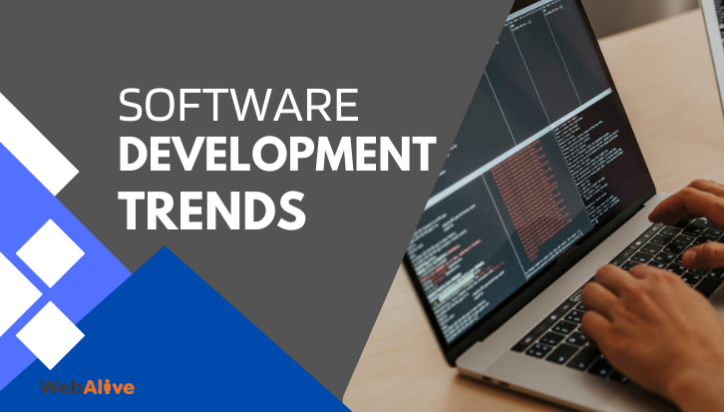
Top 10 Software Development Trends of 2025
Software development is a dynamic field. It is continuously evolving and always in flux. From the rise of blockchain technology to the usage of the cloud, there is always something new to adopt. As we are moving towards 2025, it is always a better idea to stay informed about the proven software development trends that rule the industry in 2024.
Staying updated on the latest trends will assist the industry players and software developers in maintaining a competitive edge. So, let’s look at those trends to examine their future applications.
10 software development trends to watch out for!
Software development is a crucial component of the information technology industry. Driven by continuous technological advancement and changing market demands, there has been a massive change in the way software is developed, deployed and maintained.
Hence, embracing emerging trends has become a must-follow step to succeeding in this ever-evolving field.
1. More businesses are adopting no-code and low-code development
Day by day, more businesses are looking for faster and more cost-effective solutions. As a result, they are increasingly turning to no-code and low-code developing platforms for software creation. There are many platforms that allow users to build applications with little or even no coding experience using intuitive drag-and-drop interfaces, pre-built templates and automated workflows.
Businesses are using no-code platforms to build custom CRMs tailored to their workflows, whereas retailers are creating bespoke online stores with integrations. Even start-ups are also using these platforms to develop prototypes quickly.
Eventually, there are several factors for which this approach is revolutionising, such as speed and efficiency, cost-effectiveness, customisation without complexity and more. So, since the demand for digital transformation grows, the adoption of no-code and low-code development is also expected to grow.
No wonder 70% of new business applications are expected to use no code/low code technologies by 2025.
2. The usage of cloud is rising
Cloud computing has changed the software development landscape. It is reshaping software development by making powerful tools and resources accessible to businesses of all sizes. According to a survey, the global cloud computing market size was estimated to grow at USD 602.31 billion in 2023 and is expected to grow more at a CAGR of 21.2% from 2024 to 2030.
One key advantage of integrating cloud technology into the development process is the flexibility and scalability it provides. So, it offers the ability to scale resources quickly based on project requirements and eliminates the necessity for expensive hardware investments. In addition, cloud technology enables the team to collaborate more effectively.
3. The Internet of Things (IoT) is expanding
Today, the number of IoT devices is growing exponentially. The growth has profound implications for software development as developers increasingly focus on creating solutions that cater to the unique demands of IoT ecosystems. AI-powered IoT applications have become very common as they enable predictive maintenance, smart automation and enhanced decision-making.
It transforms industries by boosting operational efficiency, reducing costs, and enabling innovative business models. Day by day, IoT is becoming more and more powerful as it can be combined with technologies like artificial intelligence (AI), blockchain and augmented reality (AR).
4. The rapid rollout of 5G is revolutionising connectivity
Creating new opportunities, 5G is set to revolutionise software development, creating new opportunities for innovation.
Why is it one of the key trends?
- Ultra-low latency
- Blazing fast speeds
- Massive device connectivity
- Enhanced mobile experiences
So, as 5G networks promise higher data speeds and lower latency, developers use this to create applications with faster response times and smoother user experiences. Mobile apps can also deliver higher user experiences by delivering high-definition video streaming, virtual reality, and augmented reality over 5G networks.
5. Python is expected to dominate the tech industry
Python keeps growing as a popular language for web and software development. It is a high-level, interpreted programming language with a simple syntax. There are several characteristics that make it popular, and these include,
- It is easy to read
- It is open source
- It is portable
- It is extendable
6. Blockchain technology is emerging
It has become a key software development trend as it enables innovation across industries. The decentralised and immutable ledger of blockchain ensures data integrity and transparency. It reduces the risk of fraud as each and every transaction is verified. The most important part is it eliminates the need for a single centralised server to host data, as this technology allows for decentralised data storage.
Several types of blockchains are used in software development. A public blockchain is a reliable and secure network that can be accessible with no special authorisation. On the other hand, a private blockchain is tailored to a company’s internal network.
7. Augmented reality and virtual reality are boosting as a game changer
AR and VR are game changers, and their potential in software development is immense. AR and VR technologies have already transformed the prototyping and design phases of web design services. Be it for creating realistic environments or for providing an immersive interaction paradigm, developers are leveraging these technologies for many reasons.
Also, AR and VR technologies facilitate remote collaboration like never before, and these are essential in web application development.
8. AI is becoming a cornerstone of innovation across industries
Artificial Intelligence is no longer a futuristic concept but has become a mainstream technology driving innovation and transforming industries. It has made it possible to develop more sophisticated and efficient software products in no time. According to the 2024 Stack Overflow Developer Survey, around 82% of developers reported that they were currently using AI tools for writing code.
Here’s how AI is changing the software development industry.
- It is boosting the project roadmap development process
- It offers data analysis
- Faster testing
- Improves collaboration
- Boosts user experience
- Minimise the cost of development
- Ensure cross-industry facilities
9. There is a growing emphasis on cybersecurity
The focus on cybersecurity has become a critical focus for software developers in 2024 as cyberattacks have become sophisticated and widespread. Governments worldwide are imposing data protection regulations such as GDPR and CCPA, and developers must ensure that the applications comply with the regulations.
That is another reason why businesses are prioritising secure digital environments more than ever. Developers are considering security as a core feature to ensure that applications are resilient against any sort of current and emerging threats.
10. Edge computing is becoming a cornerstone
Edge computing is another top trend, as it addresses the need for real-time data processing and localised decision-making. One big advantage of edge computing is that it reduces the delay in data transmission by processing information near its source.
Also, with IoT devices generating a large amount of data, edge computing makes sure that data is processed locally while minimising the need to send the information to the cloud. This improves efficiency and reduces operational costs.
Final words
Even though the software development sector in 2024 is being dominated by these prominent industry trends, there are many innovations yet to come. After all, modern technology is an unstoppable force. The ones we have mentioned here are just a few among many key trends. So, keep trying out new tools and technologies to upgrade your skills and knowledge.
You read a lot. We like that
Want to take your online business to the next level? Get the tips and insights that matter.

